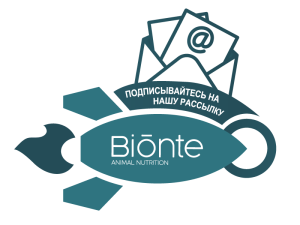Introduction
The genus Alternaria is a widely distributed group of fungi that includes more than 250 known species. These fungi can inhabit soil, act as saprotrophs (decomposing organic matter), live as endophytes within plants, cause allergies and mycoses in humans, and even act as pathogens for economically significant crops (Fernández Pinto et al., 2017).
Many Alternaria species affect key crops for animal nutrition such as wheat, maize, peanuts, sorghum, barley and alfalfa, among others. Their ability to colonize these crops reduces yield and causes significant losses during the transportation and storage of agricultural products like grains and seeds. These fungi can produce severe mold growth on fruits and compromises their commercial quality and food safety.
Alternaria fungi typically form fast-growing colonies with colors ranging from black and olive-black to grayish, with a velvety or fluffy texture. One well-known issue associated with this genus is its role as the causal agent of «black point» in small-grain cereals like wheat, a disease that impacts both the visual quality and safety of the final product.
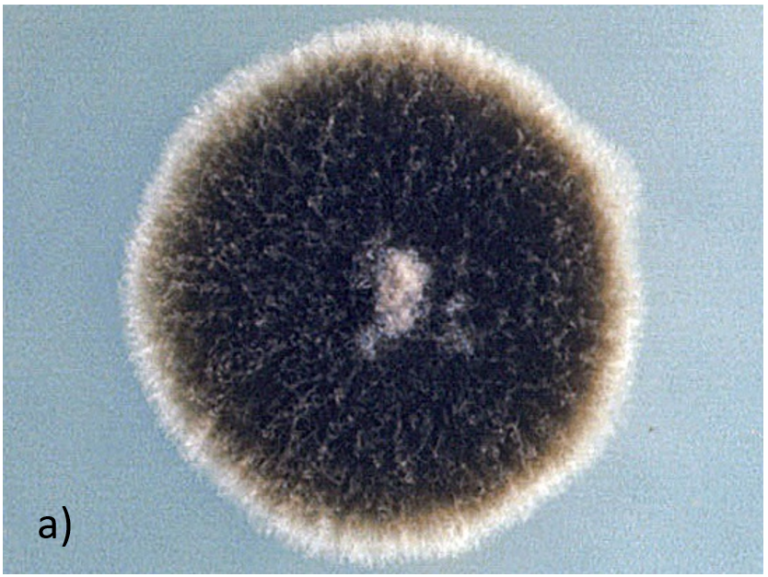
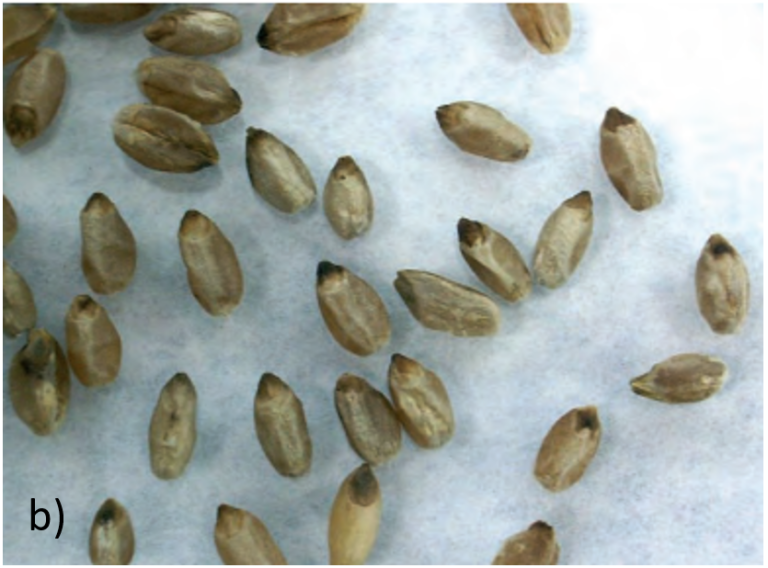
Figure 1. a) Colony of Alternaria alternata b) Durum wheat seeds with Black poiny symptoms
Morphology of Alternaria
From a morphological point of view, Alternaria species are characterized by producing specific structures:
Conidiophores
- These are supporting structures with a darker pigmentation compared to hyphae.
- They can be found individually or in clusters, often sharing a common base.
- They grow at their tips (acroauxic growth) and in a sympodial manner, giving them a bent, elbow-like appearance.
- They are generally unbranched, although in some cases, they may develop one or a few lateral branches.
Conidia
- These are reproductive structures formed through an enteroblastic process, in which they emerge through pores in the conidiophore wall.
- They can be arranged in acropetal chains (ascending order) or appear individually at the tip of the conidiophore.
- Their shape varies from subspheroidal to ovoid or ellipsoidal, with both transverse and longitudinal septa, classifying them as dictyoconidia.
- Their dark color gives them the name phaeoconidia, and the apical cell (or «beak») can take various forms, ranging from absent to filamentous or blunt structures.
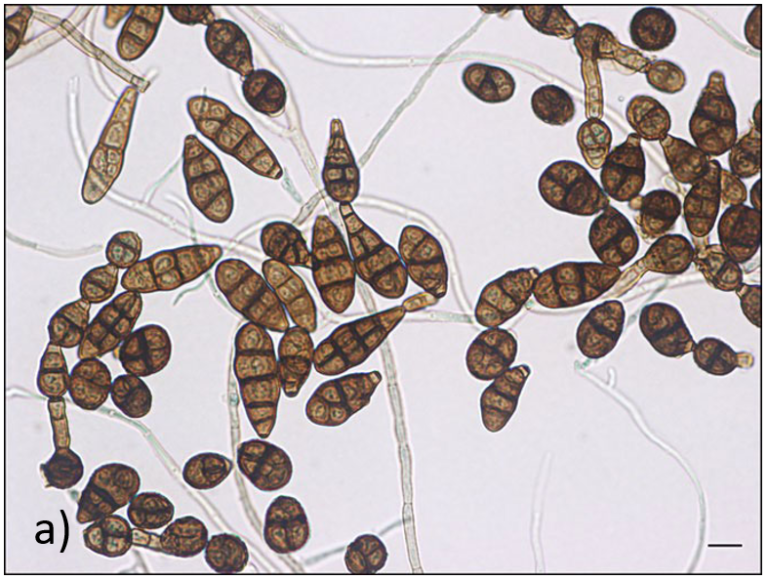
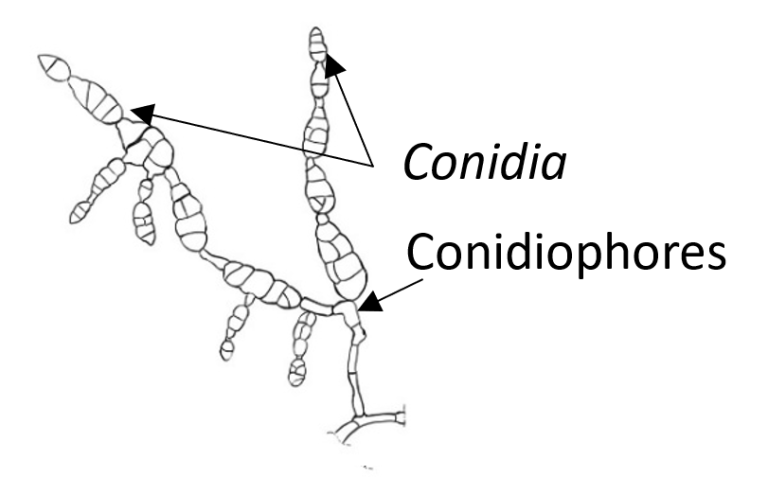
Figure 2. (a) Microscopic image of Alternaria alternata conidia (photo source: Abdulghafour, Wikimedia).b) Morphology Alternaria alternata: oval or cylindrical conidia, short geniculate conidiophore. Taken and adapted from Simmons (2007).
Proliferation of Alternaria and optimal conditions for its growth
Alternaria species not only reduce crop yields but also cause significant economic losses during the transportation and storage of plant-based products such as grains and seeds. This fungus thrives in warm and humid conditions, reaching its peak activity at the end of summer and the beginning of autumn (Hernández-Ramírez et al., 2021).
Optimal growth occurs at temperatures between 20 and 25°C, but Alternaria can develop within a broader range, from 1 to 35°C, and in pH levels between 2.5 and 10. Additionally, it requires a minimum water activity (aᴡ) level of 0.85 for its development.
The Impact of Alternaria Mycotoxins
Beyond its economic impact on agriculture, certain Alternaria species produce mycotoxins, secondary metabolites with adverse effects on human and animal health. Given its characteristics and influence on multiple fields, from agriculture to public health, the study and management of Alternaria are essential to minimizing its negative effects and ensuring safer food products.
Alternaria species produce over 70 secondary metabolites, some of which are harmful mycotoxins to humans and animals. These toxins have been detected in various fruits, vegetables and processed foods, leading to economic losses in agriculture (Moreno et al., 2012).
However, research on Alternaria mycotoxins remains limited, and further studies are needed to fully understand their effects (Hernández-Ramírez et al., 2021). Among the most studied Alternaria mycotoxins are Alternariol, Alternariol monomethyl ether, Tenuazonic acid, Altertoxins, and Tentoxin.
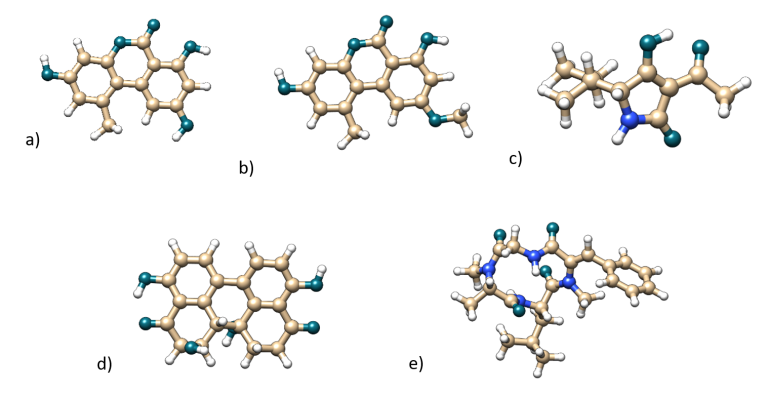
Figure 3. a) Alternariol b) Alternariol monomethyl ether c) Tenuazonic acid d) Altertoxin e) Tentoxin
Alternariol (AOH) and Alternariol Monomethyl Ether (AME)
- Effects: these mycotoxins exhibit mutagenic, carcinogenic, and cytotoxic properties in cell cultures.
- Health Impact: their consumption has been linked to increased esophageal cancer risk and inhibition of progesterone production, disrupting reproductive cycles in pigs and other mammals (Tiemann et al., 2009).
Tenuazonic Acid (TeA)
- Effects: it is a derivative of tetramic acid. It has been observed hemorrhages in various organs of mice, chickens, and dogs exposed to high doses (Pinto et al., 2007).
- Mechanism of Toxicity: it inhibits protein synthesis and alters esophageal mucosa.
Altertoxins (ATX)
- Effects: they have stronger mutagenic and genotoxic activity than Alternariol and Alternariol monomethyl ether.
- Notable Molecules: Alterotoxin I, II and III ( ATX-I, ATX-II, ATX-III)
- Absorption and Toxicity: ATX-I is absorbed through the intestinal lumen, enters the bloodstream, and has systemic effects. ATX-II, with slower intestinal absorption, primarily affects the digestive tract (Fleck et al., 2014).
- Contaminated Foods: ATX-I has been detected in sorghum, wheat, apples, and oilseeds.
Conclusions
The mycotoxins produced by Alternaria encompass a wide range of compounds that are considered emerging mycotoxins, which are not routinely monitored and lack specific regulation. The increasing prevalence of Alternaria and its toxins presents significant challenges, especially in the context of climate change, which could amplify their impact on animal feed, public health and food safety. Continuous research is crucial to enchance prevention and mitigation strategies, ensuring ongoing improvements in animal production and safeguarding food security.

